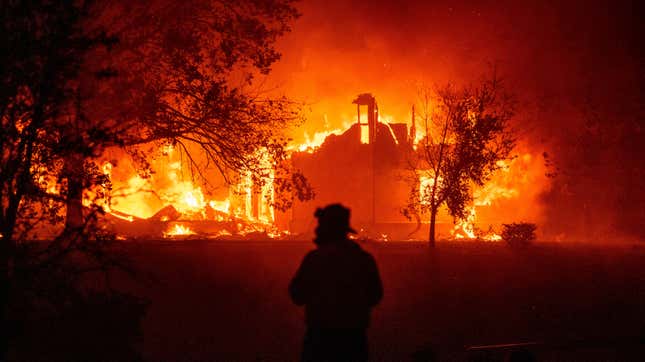
Wildfires are raging across California, but the state lacks critical firefighting resources to adequately address the severity of the crisis. In light of the coronavirus pandemic and a worse-than-usual wildfire season, wildland fighting agencies across the U.S. knew they’d be in for a challenging summer. However, California is dealing with an especially precarious situation due to its dependence on prison labor.
On Wednesday, a tweet went viral saying that the state’s incarcerated firefighters were “too sick with covid” to fight fires. The truth, though, is a little more complicated. Regardless, the whole situations raises the question: Why the hell is one of the most fire-prone states in the U.S. still so reliant on prison labor to battle blazes in the first place?
California’s fire season exploded this week due to an unusually intense heat wave and bizarre lightning storm. Firefighters are attempting to contain 367 fires across the state, the biggest of which is the LNU Lightning Complex Fire just north of the Bay Area, which has burned through more than 124,000 acres and is at 0% containment.
Incarcerated people with the California Department of Corrections and Rehabilitation (CDCR) make up more than a third of the California Department of Forestry’s (Cal Fire) non-seasonal personnel. They do critical wildfire prevention work and are deployed whenever a wildfire burns. This work cuts time off their sentences, but these workers are paid a meager $5.12 a day with an additional $1 an hour when on the fire line.
In recent years, prison reform policies have reduced the number of eligible incarcerated people—those locked up for low-level, non-violent offenses—for the conservation camp program, which includes 43 facilities. However, the numbers are likely even lower this year because CDCR has been expediting the release of non-violent offenders to protect their health during the pandemic. Now, the state has even fewer wildland firefighters during this dual health and safety crisis: Since July, the state has released at least 331 incarcerated firefighters as part of standard and expedited release processes.
The state’s wildfire season this year kicked off in earnest in June. As fate would have it, this was also right around the time that CDCR began experiencing an explosion of covid-19 cases within its prisons. By June 26, the agency placed 12 camps in quarantine with the hopes of protecting this essential workforce. Despite these efforts, CDCR still recorded 46 covid-19 cases with no deaths among incarcerated people and staff at its conservation camps, according to Aaron Francis, a CDCR information officer. Eleven of these camps remained in quarantine until mid-July. The last quarantine lifted August 14, according to CDCR, though Cal Fire maintains that one camp with two crews remains in quarantine as of Thursday.
“The health and safety of the incarcerated population and staff continue to be our top priority,” Francis wrote in an email. “We will continue to work with our partners during this pandemic to balance that priority with being able to provide assistance to California’s wildfire prevention and response efforts. At this time, incarcerated firefighters and fire crews from conservation camps across the state are actively assisting CAL FIRE with fighting California wildfires.”
While this quarantine did cause a temporary state-wide shortage in the number of available wildland firefighters, Christine McMorrow, resource management communications officer at Cal Fire, said the ongoing shortage is due to the early release program. She pointed to legislative policies the state has passed in recent years to address overcrowding in prisons, but the pandemic has reduced conservation camp populations further. In April alone of this year, CDCR released about 3,500 incarcerated people in response to the pandemic. The idea is that lowering the prison population will slow down the spread of the virus because there will be more space for social distancing and quarantine efforts. By the end of August, the agency expects to have freed some 8,000 people.
The available CDCR crews are down by 15% due to coronavirus and crews that are not fully staffed. Each fire crew needs 12 people at a minimum to fight a wildfire. Only 90 out of the 106 available CDCR crews meet the 12-person requirement to hit the frontlines.
“We are funded to hire 192 CDCR crews,” McMorrow wrote in an email. “However, due to early release programs, there are not as many available and willing inmates to staff the maximum number we are funded to hire.”
To mitigate the shortage, Cal Fire has hired an additional 858 seasonal firefighters, brought on more bulldozers, redirected six California Conservation Corps crews to work on fire-mission related tasks, and established temporary frontline hand crews. It’s also requested further assistance from out of state, including 375 fire engines. This sounds like a lot of help, but these efforts still don’t make up for the lost prison labor.
“In the current fire siege we are in today, our resources are being depleted as new fires continue to ignite,” McMorrow said.
What Cal Fire officials—and federal leaders—need to do, instead, is begin exploring long-term wildfire-fighting strategies that do not involve one of the nation’s most vulnerable populations: incarcerated people. The wildfires of today are only a glimpse of what’s to come in a hotter, drier future.
Correction, 8/21/20, 1:40 pm EST: This post has been corrected to clarify $5.12 is what these firefighters make a day, not per hour. We regret this error.